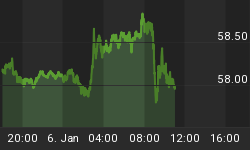Can a market positive and a market negative coexists at the same time?
The answer is: For a short period of time.
What you are describing when you discuss such conditions are "conflicting market conditions". Conditions where there is a "force in one direction" being opposed by a "force from another direction".
When the power of each of these forces is equal, there is a "standoff" where neither force has the advantage. Until one of the forces establishes the dominant position, the situation is a neutral standoff.
Let's look at such an example today. Such a "conflicting market condition" shows up when we look at our chart of New Daily Lows on the New York Stock Exchange along with our zero-based Relative Strength for the S&P 500.
This is a fascinating chart because it shows that the S&P 500 is now at a major testing point. The S&P has recently dropped down to a level that necessitates retesting the November low. The S&P has not broken below the support, or rallied yet because ...
Because ... Just as this is happening, there are "conflicting market conditions" where opposing forces are offsetting each other. Each is holding the other back from a rally or from a descent down further.
Notice what is happening on this chart.
First, the New Lows peaked in October. The New Lows were then followed by a lesser rise in November while the market made a new low on the S&P. That was a positive divergence, where the market rose from there ... only to fall back down to retest the S&P low again. But notice how, once again, the New Lows have a Positive divergence ... and this time, the divergence is more positive than the last time. So, we have a "positive force" acting on the market.
Second, look at our Relative Strength for the S&P 500. Note that the Strength for the S&P 500 is negative. Also, note that the short term trend has been moving lower. So, here we have a "negative force" in play. (Some of you may also observe that the Relative Strength also has a positive divergence when you look at the October to February time period. However, the dominant force on the Strength is a down force because it has recently made a lower/low.)
Summing up the two, you have one positive and one negative force ... a standoff as a battle of the forces fight for dominance. It isn't until such divergent forces "clear themselves off the table", that the stock market is able to establish a direction for the next trend. (The update of this chart can be seen every day on our paid subscriber site.)

















